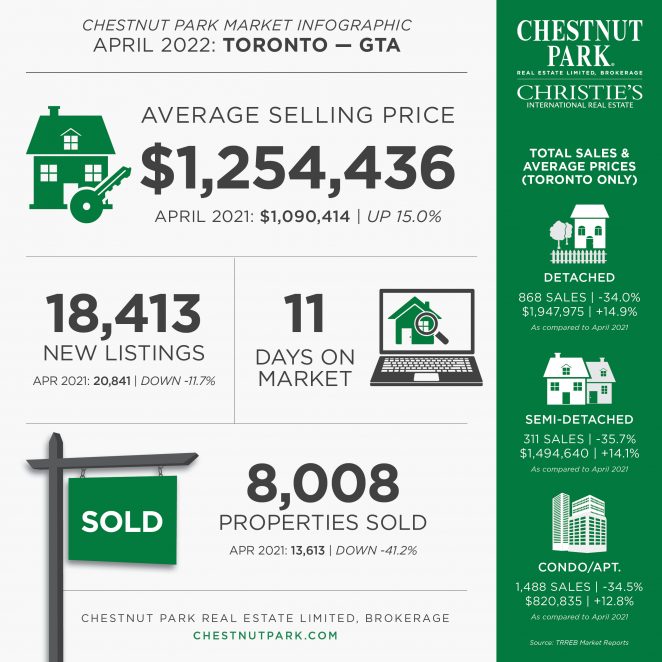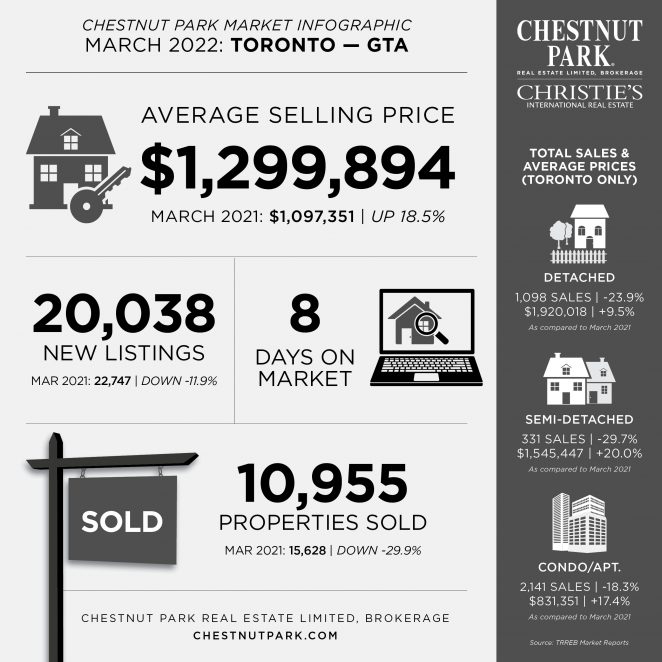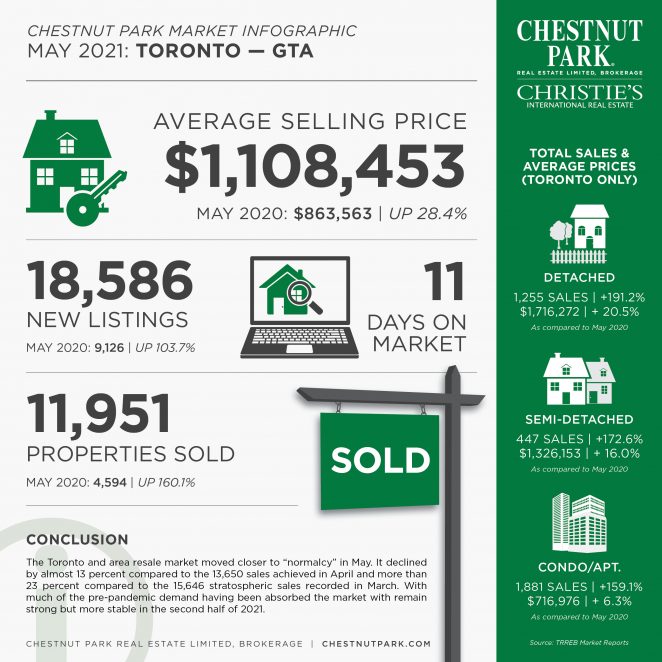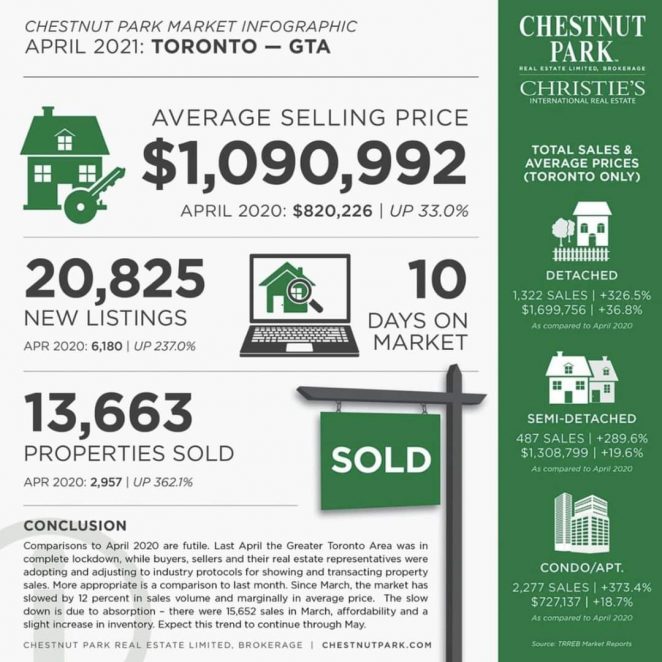Toronto Real Estate Market Update – February 2022
It’s now official, the most expensive city in Canada, at least from a housing perspective, is Toronto. February’s resale market performance pushed Toronto prices to new records, breaking records achieved only last month in January.
In February the average sale price for all properties sold, including the sale of 2,772 condominium apartments, came in at an eye-popping $1,334,544, almost 28 percent higher than the $1,044,957 achieved last February, and more than 7 percent higher than the record of $1,242,760 realized in January. Toronto and area housing prices are now more than 60 percent higher than they were at the beginning of the pandemic.
The reasons for this unbelievable increase in prices have been historically low interest rates, a lack of supply, continued growth in population (in 2021 the population of the greater Toronto area is estimated to be 6.4 million, which means that more than 1 in 6 Canadians live in the region) and the fact that there is now a prevailing view that a home is not merely bricks and mortar, where families live and grow, but the most important asset in the accumulation of wealth. The asset valuation affect at play is very similar to why people invest in the equities market, particularly when interest rates are exceptionally low, as they have been.
Given that supply is low, it is not surprising that sales in February were lower than February last year. This year 9,097, a strong number by historical standards, but almost 17 percent less than the 10,929 sales recorded in 2021, all due to supply and lack of inventory.

In February 14,147 new properties came to market, a sharp improvement from the 7,979 properties that came to market in January, but almost 7 percent fewer than the 15,146 new listings that became available to buyers last year. Consequently, heading into March there were only 6,985 available properties in the entire greater Toronto area, 20 percent fewer than at the same time last year. These are critically low numbers. To put these numbers into perspective, the available inventory today is only about a third of what was available at the beginning of 1997. With 430,000 new immigrants expected in 2022, many of whom will end up in the greater Toronto area, there is no immediate relief expected.
Average sale prices continue to be higher in the city of Toronto as compared to the 905 region, but as has been the pattern since the beginning of the pandemic, the gap between the two is narrowing.

In every category records were broken. Of particular note are the prices of detached houses in the city of Toronto, which broke the $2 million barrier. As eyepopping as this number is, in Toronto’s central trading areas the average sale price for a detached properties almost hit the $3 million mark, coming in at $2,952,369. Condominium apartment sales, what used to be the city of Toronto’s least expensive housing form, also broke records with an average sale price of $863,210. Just before the pandemic, the average price for all properties sold in the greater Toronto area was a shockingly low $819,043!
In a month that was full of new records, the time that available properties spent on the market before being reported sold can only be described as startling. In February all properties (on average) that hit the market were reported sold in only 9 days. Single digit time periods on the market have been the norm in some trading areas, but never for the entire greater Toronto area. There were 2,772 condominium apartments sold in the greater Toronto area, 1,842 of them in the city of Toronto. They all sold after spending only 11 days on market. There are no longer any meaningful superlatives to describe what is happening in the greater Toronto marketplace.
As we move into the month of March, the burning question is, will rising mortgage interest rates dampen this unprecedented marketplace? The answer to this question depends on how high and how quickly the Bank of Canada raises is rates. Its initial increase on March 2nd was only 0.25 percent, bringing the Bank rate to 0.5 percent. This increase was modest. Given all the other forces that are driving the Toronto and area marketplace, the impact on the residential resale market will be negligible and in fact may have a FOMO (fear of missing out) affect, driving people to buy now before rates get higher in the future. If rates continue to rise to pre-pandemic levels, in conjunction with the record prices for housing now at play, there is little doubt that home prices will plateau. For prices to come down, the downward asset valuation effect would need to be dramatically stronger than the overwhelming upward pressure on the house prices generated by population growth and the prevailing lack of supply.
Toronto Real Estate Market Update – December 2021
With one month still remaining in 2021, November’s reported sales brought the total year-to-date sales to 115,716 residential properties sold. We will finish the year with approximately 122,000 sales, eclipsing the previous annual record for properties sold in 2016. In that year 113,040 properties traded hands. As will become evident, given the supply problems the market is experiencing, 2021’s record-breaking accomplishment is not likely to be surpassed for some time, and definitely not in 2022.
In November 9,017 residential properties were reported sold, also a record number for any previous November. Last year 8,728 properties were sold, 3.3 percent fewer than this November. The big news coming out of the November data, aside from the new records achieved, was what’s happening to prices and the region’s disappearing inventory.
In addition to being the strongest November on record, and breaking the annual record for total sales, November saw the Toronto and area average sale price climb into record territory. The average sale price for all properties reported sold came in at $1,163,323, almost 22 percent higher than last year’s average sale price ($955,889). November marks the sixth consecutive month of monthly increases. This streak started in June when the average sale price was a “mere” $1,089,135, 7 percent less than the average sale price for November. The pace of these monthly increases in average sale price began to accelerate in September when it became evident that the Toronto and area supply problem was moving from chronic to dangerous.

The supply problem became even worse in November. Only 10,036 new listings came to market in November, 13.2 percent fewer than the 11,556 that came to market last year. Given the absorption rate – 9,017 properties were reported sold, almost the same number as came to market – combined with the few listings that realtors were able to bring to the market, we find ourselves entering December with only 6,086 properties available to buyers, an eye-popping 56 percent fewer listings (13,798) than at the same time last year.
As unbelievable as these numbers are, depending on housing type and neighbourhood, the situation is even direr. For example, there were trading districts that reported no sales of semi-detached properties for November. The reason no sales were reported is due to the unnerving fact that no semi-detached properties came to market in November in those trading areas.
No surprise that sales of all types of properties were happening at lightning speed. In the City of Toronto, all detached properties were reported sold in just 13 days. Semi-detached properties sold in just 11 days. In the 905 region, all semi-detached properties that came to market in November sold in a mere 8 days with some trading areas reporting sales at an even faster pace. All sales of semi-detached properties in Halton, which includes Burlington, Milton, and Oakville, were processed in only 4 days!
Another milestone that was achieved in November was months of inventory. Given the data in this report, it won’t surprise anyone that for the first time months of inventory for the greater Toronto area dropped below one month. For the entire region, months of inventory came in at 0.9 months.
In some trading areas, this number was, unbelievably, even lower. Durham region, which includes Ajax, Uxbridge, Oshawa, and Pickering ended the month with only 0.5 months of inventory. As this report is making clear, the 905 region is even more active than the City of Toronto. This is also evident in what’s happening to prices in the 905 region. In November, average sale prices increased much more dramatically in the 905 region than in the City of Toronto, including condominium apartments.

Prices continue to be lower in the 905 region compared to the City of Toronto, but as 2021 winds down that disparity is beginning to diminish. In the City of Toronto the average sale price for detached properties reached record territory at $1,808,000 and similarly for semi-detached properties, with prices coming in at $1,432,000. As we move into the last month of 2021, condominium apartments are the largest housing type available to buyers, but that supply is also declining, while average sale prices for condominium apartments continue to rise.
At the beginning of December there were 2,689 active condominium apartments available to buyers. These 2,689 condominium apartments represent more than 44 percent of the entire available stock of all property types. At the beginning of October, there were 3,440 condominium apartments available for buyers, a shocking decline of 22 percent in only one month. With these dwindling numbers it is no surprise that the average sale price for condominium apartments in the City of Toronto’s central core (where most of the supply is located) is now over $800,000.
Given the enormous demand, stimulated by the expectation the mortgage interest rates will rise, perhaps as early as the first third of 2022, December, which is historically a slow selling month, to the extent that low supply will allow it, will emulate November’s activity – average sale prices will increase; inventory levels will continue to decline, especially for detached and semi-detached properties; sales will take place at the speed of light, the 905 region will outpace the City of Toronto in sales and price growth; and, as has been the case since September, average sales prices throughout the greater Toronto area, will all exceed asking prices, on average by about 110 percent.
The tension in the Toronto and area housing market (demand struggling with supply leading to record-breaking average sale prices) will not miraculously resolve itself. In order to increase supply all three levels of government, and particularly at the municipal level, must work co-operatively to intelligently free up land, increase density by filling the missing middle, and reduce regulatory and planning red tape and bureaucracy so that more housing can be built to satisfy the ever-growing demand at something approaching affordable levels.
Toronto Real Estate Market Update – October 2021
Key points emerging from October’s data: average sale price has reached record highs, while supply has fallen to record lows. Demand remains strong and robust, but the lack of supply is making it impossible for buyers to find homes to buy. This is driving up prices. The decline in sales year-over- year is a product of low supply. Without the availability of condominium apartments the decline would be even lower. Expect these key points to drive the market to year end and into 2022.

Toronto Real Estate Market Update – December 2020
Below is the December 2020 statistics for the Toronto Real Estate Market:

Toronto Real Estate Market Update – November 2020
The Toronto and area residential resale market continued its torrid pace in November, defying all expectations and forecasts. It wasn’t, however, homogenous in its performance, with different housing types and areas performing at dramatically different levels.
Overall, reported sales for the greater Toronto area were up a scorching 24.3 percent compared to November 2019. Last year, 7,054 residential properties were reported sold. This year that number jumped to 8,761. That number was driven primarily by the sale of ground-level properties, detached, semi-detached, and townhouse homes. Sales of these types of homes increased in both the City of Toronto and the 905 region, and correspondingly, so did average sale prices.
In November, the average sale price for all properties sold across the greater Toronto area came in at $955,615. This number was more than 13 percent higher than the $843,307 achieved in November of 2019. In the City of Toronto, the average sale price was even higher, coming in at $979,224. These numbers would have been even higher if not for the lagging performance of condominium apartment sales in the City of Toronto.
Once again, as in previous months, resale data indicates that market activity has shifted from the City of Toronto to the 905 region. The 905 region includes Halton, Peel, York, Durham, Dufferin, and Simcoe Counties. Of the 8,761 reported sales for the greater Toronto region, 5,729, or 65 percent, were in the 905 region. What we also witnessed in November was the average sales price gap between the City of Toronto and the 905 region is narrowing. For the third straight month, average sale price gains in the 905 region far outdistanced gains in the City of Toronto. The average price increase for all property types in the City of Toronto was 5.5 percent. In the 905 region the average sale price jumped by 14 percent. Even if condominium apartment sales were extracted from these numbers, gains in the 905 were at least double the average sale price gains in the City of Toronto.
Except for condominium apartment sales in the City of Toronto the entire resale marketplace continued to move at a torrid pace. In November, all sales across the greater Toronto area sold (on average) in only 19 days, 26 percent faster than the 24 days it took last year. The pace for semi-detached properties in the City of Toronto was even more hectic. All semi-detached properties sold in only 14 days. Toronto’s eastern districts, which include the popular Riverdale, Leslieville, and Beaches trading areas, saw semi-detached properties sold in only 11 days, and (on average) for 109 percent of their asking price. The average sale price for the combined eastern districts for semi-detached properties exceeded $1 million, with substantially higher average sale prices in the most popular neighbourhoods. Similar results were achieved in Toronto’s western districts. Because of higher price points, Toronto’s central district sales were a little slower (20 days) but still managed to achieve sales prices that were 102 percent of the asking price.
It should be noted that the high end of the market also put on a strong performance. Throughout the greater Toronto area, 356 properties with an average sale price of $2 million or more were reported sold in November. This compares with only 199 sold in the same category last year. On a year-to-date basis, 3,363 $2 million plus properties have been reported sold. Last year, at the end of November, 2,171 properties at this price point were reported sold. This year’s sales represent a 55 percent increase in high-end property sales compared to 2019.
If there is a dark spot in the greater Toronto resale marketplace it’s condominium apartment sales in the City of Toronto. In November, sales were flat, and average sale prices fell off by 3 percent. Unfortunately, that’s not the whole story. Inventory levels are increasing dramatically. In November, 2,943 new condominium apartments came to market (some of these were no doubt new listings of units that hadn’t sold and were being re-introduced to the market, often at lower asking prices). Last year, only 1,629 new listings came to market. November’s new listings increased the total number of active listings to 5,018, 194 percent higher than the 1,707 condominium apartments available to buyers at the same time last year.
On a more positive note, by the end of November, year-to-date, 88,026 properties (all types) were reported sold for the greater Toronto area. Total sales for 2019 were only 87,753. Notwithstanding the pandemic, and its negative impact on our society, our businesses, and our health and safety, with December still to be counted, 2020 will be the Toronto and area’s best year for resale house sales since 2016. Astonishing.










